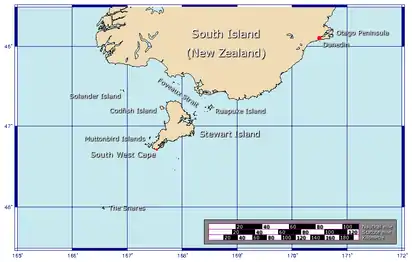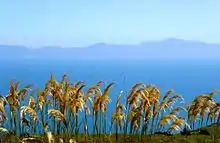Foveaux Strait
Foveaux Strait (Te Ara a Kiwa ("the path of Kiwa") or Te Ara a Kewa ("the path of the whale"[1]) (Māori) separates Stewart Island, New Zealand's third largest island, from the South Island.[2] According to a Maori legend, the strait was created by Kewa the obedient whale when traditional Maori ancestor Kiwa summoned the whale to create a waterway.[3] Three large bays, Te Waewae Bay, Oreti Beach and Toetoes Bay, sweep along the strait's northern coast, which also hosts Bluff township and harbour. Across the strait lie the Solander Islands, Stewart Island, Dog Island and Ruapuke Island. The strait is about 130 km long (from Ruapuke Island to Little Solander Island), and it widens (from 14 km at Ruapuke Island to 50 km at Te Waewae Bay) and deepens (from 20 to 120 m) from east to west. The strait lies within the continental shelf area of New Zealand, and was probably dry land during the Pleistocene epoch.[4]

Margaret Cameron-Ash claims that James Cook sighted Foveaux Strait during his circumnavigation of the South Island in March 1770, but hid his discovery for reasons of military and colonial policy.[5] Mawer, however, argues that it is more likely that Cook simply made an error, as his focus was on finding the southern extent of New Zealand, and conditions were unfavourable for more closely exploring the possible strait.[6]
The strait was first charted by Owen Folger Smith, a New Yorker who had been in Sydney Harbour with Eber Bunker from whom he probably learned of the eastern seal fishery. Smith charted the strait in the whaleboat of the sealing brig Union (out of New York) in 1804 and on his 1806 chart it was called Smith's Straits. This chart was given to Governor Philip Gidley King, who did not make it public. This seems a strange action on behalf of King, who was duty bound to communicate all hydrographic discoveries to the Admiralty.[7] The sealing brig Pegasus, commanded by Eber Bunker, ran aground in the strait in 1809, and in the report on this in the Sydney Gazette, the strait was called Foveaux Strait,[8] after Joseph Foveaux, Lieutenant-Governor of New South Wales in 1808–1809.[9][4]

Whaling stations operated on the shores of the strait in the nineteenth century.[10]

Foveaux Strait is home to the Bluff oyster fishery, the oysters are harvested by a fleet of dredging boats - mostly operating from Bluff Harbour in the South Island - between March and August each year.[11] Oystering began on Stewart Island during the 1860s, and gradually moved into the strait with the discovery of larger oyster beds there in 1879.[12]
The strait is a rough and often treacherous stretch of water. In 2006, six muttonbirders died when their trawler sank while returning to Bluff. From the years 1998 to 2012 there were a total of 23 fatalities in the Strait.[13]
John van Leeuwen swam it on 7 February 1963, in a time of 13 hours 40 minutes.[4]
References
- Whales and Māori society - Whale place names and imagery
- "Place name detail: Foveaux Strait". New Zealand Gazetteer. New Zealand Geographic Board. Retrieved 28 March 2009.
- "Archived copy" (PDF). Archived from the original (PDF) on 7 September 2017. Retrieved 4 July 2017.CS1 maint: archived copy as title (link)
- "Foveaux Strait". An Encyclopaedia of New Zealand. 1966. Retrieved 5 March 2010.
- Cameron-Ash, M. (2018). Lying for the Admiralty. Sydney: Rosenberg. p. 139-145. ISBN 978-0-6480-4396-6.. But see also G.A. Mawer, review of Lying for the Admiralty: Captain Cook's Endeavour Voyage, The Globe, No. 84, 2018, pp.59-61; Nigel Erskine, “James Cook's False Trail: Hidden Discoveries, Altered Records”, Signals, No. 125, Dec 2018-Feb 2019 pp.72-73.
- Mawer, GA (2018). "Lying for the admiralty: Captain Cook's endeavour voyage [Book Review] [online]". Globe, The. No. 84, 2018: 59–61 – via ProQuest.
- Howard, Basil. and Stewart Island Centennial Committee. Rakiura: a History of Stewart Island, New Zealand, Basil Howard Reed for the Stewart Island Centennial Committee,Dunedin,1940, p.22; Charles A. Begg and Neil C. Begg, Port Preservation, Christchurch, Whitcombe & Tombes, 1973, p.61; Peter Entwisle, Behold the Moon: The European Occupation of the Dunedin District 1770-1848, Dunedin, Port Daniel Press, 1998.
- Sydney Gazette, 12 March 1809.
- John O'C. Ross, William Stewart, Sealing Captain, Trader and Speculator, Aranda (A.C.T), Roebuck Society, 1987, p.100; Anne-Marie Whitaker, “From Norfolk Island to Foveaux Strait: Joseph Foveaux’s Role in the Expansion of Whaling and Sealing in Early Nineteenth Century Australasia”, The Great Circle, vol.26, no.1, 2004, pp.51-59.
- Don Grady (1986) Sealers & whalers in New Zealand waters, Auckland, Reed Methuen, p.150. ISBN 0474000508
- "High demand for recession-proof oysters". New Zealand Herald. 2 March 2009. Retrieved 2 March 2009.
- "Bluff Oysters & Oystering". Bluff Promotions. Archived from the original on 6 March 2010. Retrieved 5 March 2010.
- Rudd, Allison (7 December 2012). "Memorial planned for those lost in Foveaux". Otago Daily Times. Allied Press Limited 2007. Retrieved 11 December 2012.